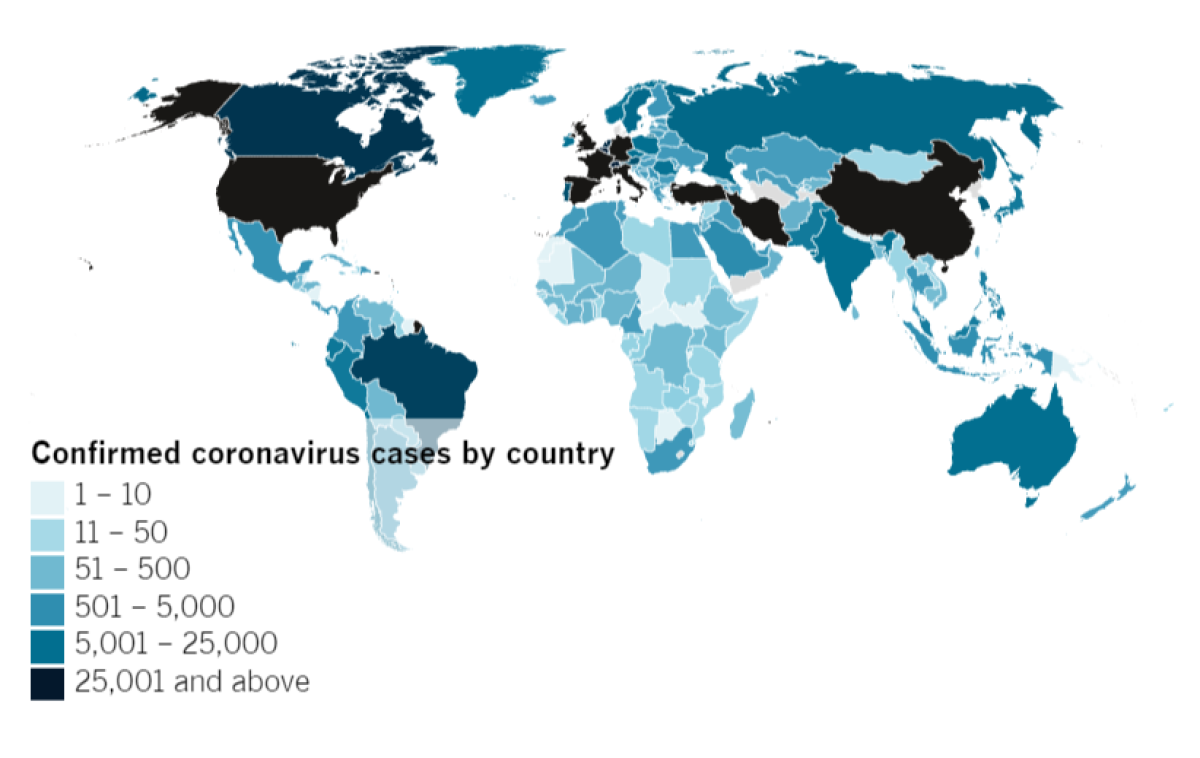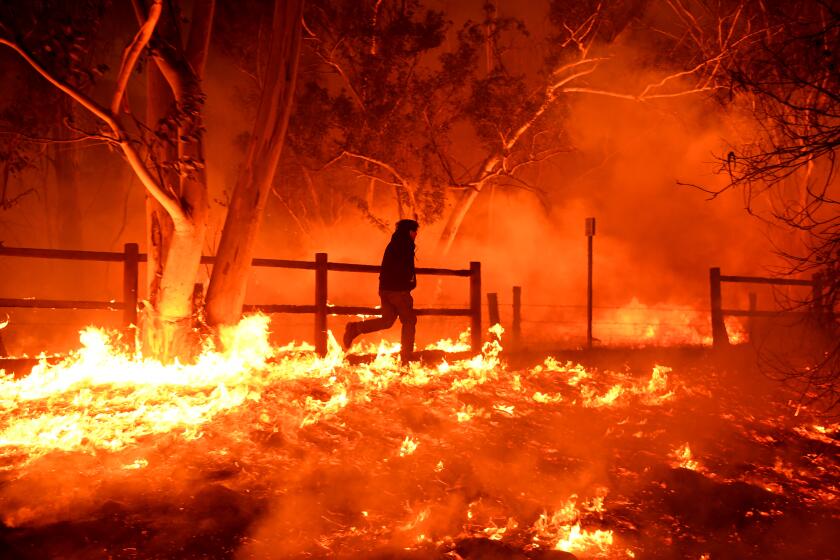Coronavirus Today: How our elders keep us strong
- Share via
Good evening. I’m Diya Chacko, and it’s Wednesday, April 8. Here’s what’s happening with the coronavirus outbreak in California and beyond.
The coronavirus models health experts use to predict sickness and death vary widely, and they rely on specific assumptions about what people and governments are doing to stop the contagion. But the apparent effects of social distancing in three major hot spots — Italy, New York and California — have given scientists hope that the final U.S. death toll could be lower than initial White House projections. “All of the available information strongly suggests that social distancing policies are making a big difference,” said an advisor to the University of Washington’s coronavirus modeling team.
But social distancing directives came late in Texas, Florida and some other states in the South, and big spikes of COVID-19 patients — especially if they occur simultaneously — could push fatalities higher if hospitals are overwhelmed. One hospital in Georgia is struggling to treat a community afflicted with one of the nation’s most intense outbreaks, one taking a heavy toll on black residents. Cities across the nation, including Los Angeles, have reported disproportionately high death rates among black people, with public health experts saying the racial disparity reflects deep-rooted social and economic inequalities.
Members of communities burdened with higher smog levels — which tend to include a disproportionately high percentage of blacks and Latinos — are at greater risk of dying from COVID-19, according to a new Harvard study that was released before undergoing the usual peer review in response to the growing number of deaths. The findings suggest health officials should pay closer attention to the worst-polluted communities, including many in California, where residents’ health has long suffered from poor air quality. “If COVID infects you, because you have lungs that are already inflamed because you’ve been breathing polluted air for so long, you might experience a worse health outcome than somewhere else,” one of the study authors explained.
For people with acute respiratory failure or seriously compromised lung function, mechanical ventilation has become the gold standard of care. But with ventilators in notoriously short supply, physicians are scrambling to find alternatives for patients, such as BiPap machines that deliver oxygen through a mask, and the Hemolung system, which removes carbon dioxide from the blood.
As people try to cope with the stress of the pandemic, elders who have survived past hardships have become a great source of strength for their families. Many are immigrants who arrived to the U.S. as refugees from war, persecution and natural disasters. One man says he learned from his mother, in the aftermath of the 1985 Mexico City earthquake, “how to buckle down, how to tighten our belts and not add to the paranoia that’s out there.” And a doctor who treated Ebola patients has used her experience to calm the fears of colleagues on the COVID-19 front lines. “She has the ability to say, ‘Yes, this is a terrible disease, but that doesn’t mean it’s panic-inducing,’” said one of her former teammates.
Got a silly or embarrassing COVID-19 question? We found a virologist to answer the ones you might have thought about, but don’t want to ask publicly. You can watch the whole Q&A session on YouTube.
By the numbers
California cases and deaths as of 4:30 p.m. PDT Wednesday:
Track the latest numbers and how they break down in California with our graphics.
Where is the coronavirus spreading?

Your support helps us deliver the news that matters most.
Across California
California officials expect some social distancing policies to remain in place for months and warn that lifting the strict rules too early could worsen the health crisis. Gov. Gavin Newsom repeated Wednesday that the duration of the coronavirus stay-at-home order is dependent on whether Californians continue to follow it and wear appropriate face coverings when they go out.
Newsom told MSNBC host Rachel Maddow that California has secured a monthly supply of 200 million N95 respiratory masks and surgical masks to help protect healthcare workers and other essential personnel: “We decided enough’s enough. Let’s use the power, the purchasing power of the state of California, as a nation-state.” Newsom has said California must be self-reliant and cannot depend on the federal government for help, and new records show the Trump administration has sent hundreds of thousands of masks, respirators and other protective equipment from its stockpile to states with very small outbreaks, leaving medical workers in areas hit hardest scrambling to find what they need.
Los Angeles County residents have significantly more confidence in their local government than in the federal government, according to a new UCLA poll, which also found overwhelming numbers of Angelenos expressing deep anxiety about contracting COVID-19. “People view this as an existential crisis,” said a retired L.A. County supervisor who oversaw the poll. “They wouldn’t be adhering to this protocol of staying cooped up in their homes if they didn’t think there was a good reason for it.”
While health officials have ramped up coronavirus testing in recent days, California still lags behind most other states, leaving potentially thousands of people to unknowingly spread the virus. For those without a fever or other symptoms, getting a test remains extremely difficult. L.A. County is planning to expand testing access to South L.A. residents to better determine how diverse communities are being affected. A mobile testing site opens Wednesday at the Charles R. Drew University of Medicine and Science.
As the virus spreads through correctional facilities, the state has launched a 14-day soft lockdown in prisons and told exhausted prison nurses that if they’re ordered to work 16-hour shifts, they must comply or face reprisal. One medical worker said the stress was intense: “There is no such thing as ‘social distancing’ in prison.” A member of L.A. County jail’s nursing staff who died last week tested positive for COVID-19.
Food banks and pantries around Southern California are ramping up efforts to distribute large quantities of food to those who have lost jobs or income. Whether you’re looking for food or looking to help, the Los Angeles Regional Food Bank has a comprehensive database of local pantries at lafoodbank.org.
How to stay safe
— Wash your hands for at least 20 seconds! Here’s a super-fun how-to video.
— Stop touching your face, and keep your phone clean.
— Watch for symptoms including fever, cough and shortness of breath. If you’re worried you might be infected, call your doctor or urgent care clinic before going.
— Practice social distancing, such as maintaining a six-foot radius of personal space in public.
— Wear a mask if you leave home for essential activities, the CDC now says. Here’s how to do it right.
— Here’s how to care for someone with COVID-19, from monitoring their symptoms to preventing the virus’ spread.
How to stay sane
— Was your job affected by the coronavirus? Here’s how to file for unemployment.
— Here are all the ways to stay virtually connected with your friends.
— Visit our free games and puzzles page for daily crosswords, card games, arcade games and more.
— Here are some free resources for restaurant workers and entertainment industry professionals having trouble making ends meet.
— Advice for helping kids navigate pandemic life includes being honest about uncertainties, acknowledging their feelings and sticking to a routine. Here’s guidance from the CDC.
Around the nation and the world
In New York, at least twice as many people have died from the coronavirus as in the Sept. 11, 2001, terrorist attacks. Gov. Andrew Cuomo ordered the state’s flags lowered to half-mast as the confirmed death toll there reached 6,268.
The question of whether a state can ban abortions — albeit on a temporary basis — in the midst of a public health emergency now appears increasingly likely to reach the Supreme Court. Texas is one of several Republican-led states that included abortion among the nonessential healthcare procedures that they said needed to stop because of the coronavirus outbreak, and a federal appeals court has now ruled in Texas’ favor.
Wisconsin‘s election on Tuesday ended in political and legal chaos that may herald the beginning of a national battle over how democracy will function in the middle of a pandemic that has health officials urging citizens to stay home. Republicans have long seen efforts to expand voting access as attempts by Democrats to gain an advantage, and now they are pursuing a coordinated national effort to limit the expansion of absentee and mail-in voting as alternatives to casting ballots in person in light of the pandemic — measures that independent election-integrity experts advocate.
More U.S. states, including California, are granting early release to thousands of older, nonviolent incarcerated people considered at risk for contracting the coronavirus — but Arizona has balked. The state is among several facing intense criticism for what civil rights groups, families of prisoners and corrections officers say is a haphazard response to the rising number of COVID-19 cases in overcrowded prisons.
The pandemic is short-circuiting the intricate network of producers and suppliers needed to power the global food system, affecting everything from caviar to apple juice. Once-unpopular items like frozen orange juice and canned tuna are now suddenly back in vogue.
Your questions answered
A number of our readers have asked: Now that officials want everyone to wear masks, where can I buy one? Here’s what we know.
Effective Friday, Los Angeles residents and workers must wear a mask, bandanna or other type of covering over their noses and mouths when visiting grocery stores and other essential businesses.
Some local apparel makers — LiquidSky Sports in Burbank, SwimSpot in Thousand Oaks and Manahan+Co in Chinatown — have shifted their production to include cloth face masks that can be purchased online, but you may have to join a waiting list. And it might not be easy to source cloth masks from Amazon or other big online retailers that have run out of supplies or been inundated by scammers and price-gougers.
If you don’t want to wait, you can make your own mask out of a T-shirt, bandanna, towel or plain cotton cloth. The Centers for Disease Control and Prevention has instructions for making no-sew masks out of such closet staples. You can even create a face covering from a sock, as features editor Rene Lynch demonstrates.
For more, read our big how-to guide on masks — how to make them, clean them and use them correctly.
Got a question? Our reporters covering the coronavirus outbreak want to hear from you. Email us your questions, and we’ll do our best to answer them. You can find more answers in our Frequently Asked Questions roundup, and in our morning briefing.
For the most up-to-date coronavirus coverage from The Times, visit our live updates page, visit our Health section and follow us on Twitter and on Instagram.





